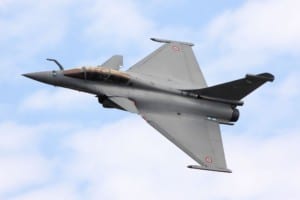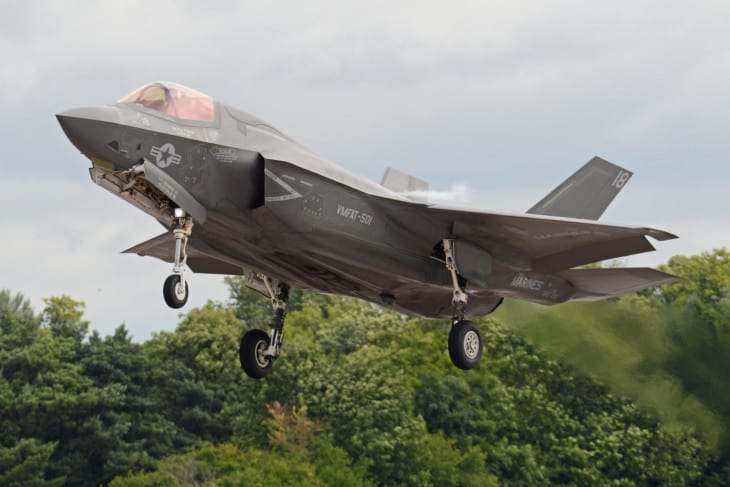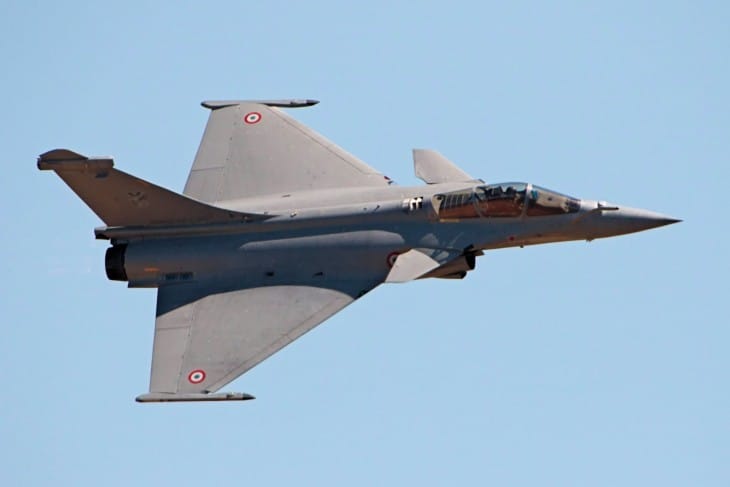The F-35 vs. Rafale debate has been raging for years, and it doesn’t seem like it will stop anytime soon. So, which one is the best fighter jet? We will look at both planes and try to answer that question.
| Aircraft: | Lockheed Martin F-35 Lightning II | Dassault Rafale |
|---|---|---|
| Photo: |
 |
 |
| Country: | United States | France |
| Manufactured: | from: 2011 to: Present | from: 2000 to: Present |
| ICAO: | F35 | RFAL |
| Price: | $115.5 million | $120 million |
| Avionics: | JSF Cooperative Avionics | Integrated Modular Avionics, Thales RBE2 AA AESA radar, Thales SPECTRA Electronic Warfare system. |
| Engine: | 1x Pratt & Whitney F135-PW-100 | 2x 2 X SNECMA M88-2 Turbofans |
| Engine Type: | Turbofan | Turbofan |
| Power: | 43,000 pound-force | 17,000 pound-force |
| Max Cruise Speed: |
1043 knots 1,932 Km/h |
1200 knots 2,222 Km/h |
| Approach Speed (Vref): | 250 knots | 120 knots |
| Travel Range: |
1,500 Nautical Miles
2,778 Kilometers |
2,000 Nautical Miles
3,704 Kilometers |
| Fuel Economy: |
0.94 nautical mile / gallon 0.460 kilometres / litre |
0.63 nautical mile / gallon 0.308 kilometres / litre |
| Service Ceiling: | 65,000 feet | 55,000 feet |
| Rate of Climb: |
40000 feet / minute 203.20metre / second |
60000 feet / minute 304.80metre / second |
| Take Off Distance: |
168 metre 551.17 feet |
400 metre 1,312.32 feet |
| Landing Distance: |
213 metre 698.81 feet |
450 metre 1,476.36 feet |
| Max Take Off Weight: |
31,751 Kg 69,998 lbs |
24,500 Kg 54,013 lbs |
| Max Landing Weight: | - | - |
| Max Payload: |
8,160 Kg 17,990 lbs |
9,520 Kg 20,988 lbs |
| Fuel Tank Capacity: |
2,760 gallon 10,448 litre |
4,370 gallon 16,542 litre |
| Baggage Volume: | - | - |
| Seats - Economy: | 1 seats | 2 seats |
| Seats - Business Class: | - | - |
| Seats - First Class: | - | - |
| Cabin Height: | - | - |
| Cabin Width: | - | - |
| Cabin Length: | - | - |
| Exterior Length: |
15.7 metre 51.51 feet |
15.27 metre 50.10 feet |
| Tail Height: | 4.48 metre - 14.70 feet | 5.34 metre - 17.52 feet |
| Fuselage Diameter: | - | - |
| Wing Span / Rotor Diameter: |
10.7 metre 35.10 feet |
10.9 metre 35.76 feet |
| Wing Tips: | No Winglets | No Winglets |
| More Info: | Lockheed Martin F-35 Lightning II | Dassault Rafale |
|
Data presented is for entertainment purposes and should not be used operationally.
|
Other Lockheed Martin F-35 Lightning II comparisons:
- Su-27 vs F-35
- F-35 vs F-15
- F-35 vs F/A-18
- F-35 vs J-20
- F-35 vs MiG 25
- F-35 vs F-16
- F-35 vs Saab Gripen
- F-35 vs A-10 Warthog
- F-35 vs Su 57
- F-35 vs MiG-29
- F-35 Lightning II vs A-10 Warthog
- F-22 Raptor vs F-35 Lightning II
- Eurofighter Typhoon vs Lockheed Martin F-35 Lightning II
Other Dassault Rafale comparisons:
Lockheed Martin F-35 Lightning II

The United States Department of Defense commissioned the development of the F-35 in 2001. The stated purpose was to create a “next-generation” stealth fighter that would serve as a multi-role aircraft capable of performing a variety of missions, including air-to-air combat, ground attack, and intelligence gathering.
The F-35 has been controversial, with some critics arguing that it is too expensive and its capabilities are duplicative of existing aircraft. However, the F-35 remains in production, with over 400 aircraft delivered as of 2019.
Dassault Rafale

The Rafale is a twin-engine, fourth-generation fighter aircraft designed and built by Dassault Aviation. It first flew in 1986 and was introduced to service in 2001. The Rafale was developed as a multi-role fighter aircraft for the French Air Force and Navy. It is also currently used by the Indian Air Force and the Egyptian Air Force.
The Rafale is equipped with a wide range of weaponry and can be configured for air-to-air and air-to-ground missions. It has a maximum range of over 1,900 miles and a top speed of Mach 1.8. Rafale has been widely praised for its performance and involved in several combat operations, including the Libyan conflict and the war in Afghanistan.
Differences between the F-35 & Rafale
The F-35 and the Rafale are the most famous fighter jets today. Both jets are designed for air-to-air combat and have a similar range and payload capacity. However, several key differences between the two jets set them apart. For example, the F-35 is a fifth-generation jet incorporating stealth technology, while the Rafale is a fourth-generation jet without stealth capabilities.
Additionally, the F-35 is equipped with sensors that allow it to collect and share data with other aircraft and ground units in real-time, while the Rafale does not have this capability. Finally, the F-35 has a more powerful engine than the Rafale, providing incredible combat speed and agility. As a result of these differences, the F-35 is generally considered a more advanced and capable fighter jet than the Rafale.
Similarities between the F-35 & Rafale
The F-35 and Rafale are two of the most famous fighter jets in the world. Though they have many differences, there are also some similarities. Both jets are highly maneuverable, equipped with advanced avionics, and capable of carrying various weapons. In addition, the F-35 and Rafale have been designed to operate in various conditions, from the Arctic to the desert.
There are many similarities between the F-35 and the Rafale, but there are also some key differences. Both aircraft are designed for air-to-air combat and equipped with state-of-the-art avionics and sensors. However, the F-35 is a fifth-generation fighter, while the Rafale is a fourth-generation fighter. The F-35 has several advantages over the Rafale, including more powerful engines, advanced stealth technology, and a higher top speed.
In addition, the F-35 can carry more ordnance than the Rafale, making it a more versatile platform. However, one of the most significant differences between the two jets is their price tag. The F-35 is significantly more expensive than the Rafale due to its extensive research and development costs. As a result, only a handful of countries have been able to purchase the jet.
In contrast, several nations, including France, Egypt, and Qatar, have bought Rafale. Though they share some similarities, the F-35 and Rafale are two very different fighter jets. Finally, the F-35 is significantly cheaper than the Rafale, making it a more cost-effective option for many air forces.
What’s better about the F-35?
The F-35 is an excellent aircraft for many reasons. Here are four things that make it better than other aircraft:
It’s a 5th generation fighter:
It has many advanced features that set it apart from older jets. For example, the F-35 has low-observable stealth capabilities, integrated avionics, and advanced sensors.
It’s highly maneuverable:
They are making it a formidable opponent in air-to-air combat. It can also perform well in air-to-ground missions thanks to its precision targeting capabilities.
It’s designed with pilot safety in mind:
It features an ejection seat that can safely launch pilots at high altitudes and speeds, and a reinforced steel frame surrounds the cockpit.
It can be equipped with a variety of weapons:
This flexibility allows the jet to be used in various mission types.
What’s better about the Rafale?
The Rafale is a French fighter jet that has been getting much attention lately. While it’s not the newest or most advanced jet on the market, a few things make it stand out. Here are four things that make the Rafale better than other fighter jets:
It’s highly maneuverable:
Thanks to its “delta wing” design, the Rafale can turn tightly without losing speed or altitude. It makes it perfect for dogfights or evading enemy fire.
It has an advanced electronic warfare system:
This system can jam enemy radar and communication signals, making it more difficult for them to target the Rafale.
It has a powerful engine:
It can reach speeds of up to Mach 1.8, almost twice the speed of sound!
It’s armed with a variety of weapons:
Including missiles and bombs allows it to take on any enemy, whether in the air or on the ground.
The Rafale is an excellent fighter jet with a lot to offer. It’s maneuverable, fast, well-armed, and easy to maintain – what more could you ask?
Conclusion
Overall, the F-35 is more advanced and capable than the Rafale. While both jets have their strengths, the F-35 has many advantages over its French counterpart, including better stealth capabilities, a more maneuverable design, higher top speeds, and greater ordnance capacity.


